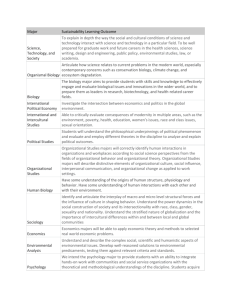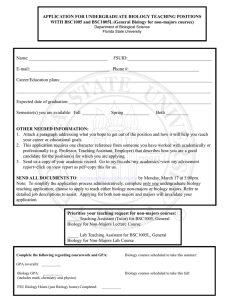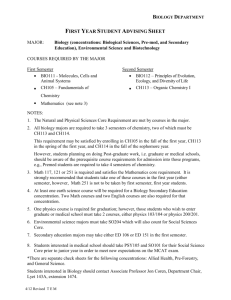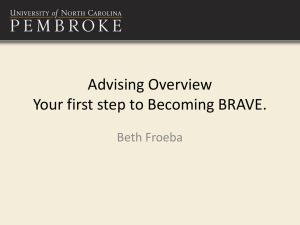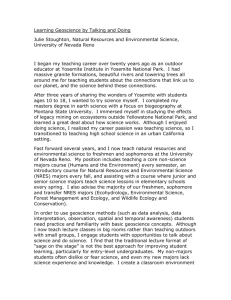Scaffolding the Freshman Biology Lab Experience in the
advertisement
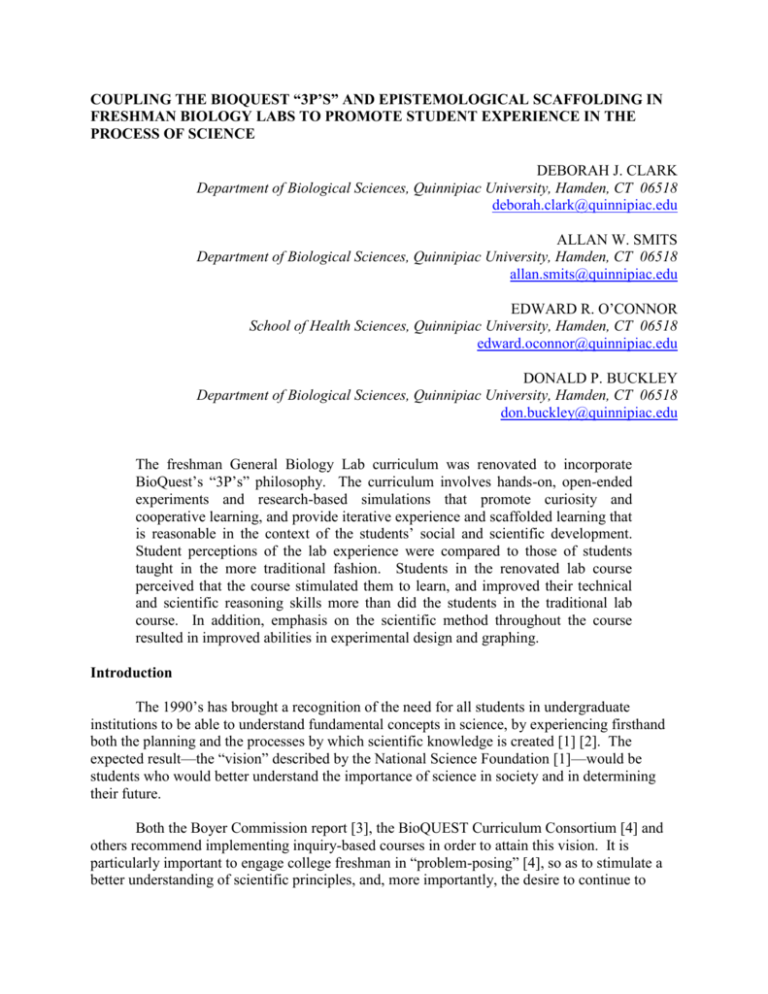
COUPLING THE BIOQUEST “3P’S” AND EPISTEMOLOGICAL SCAFFOLDING IN FRESHMAN BIOLOGY LABS TO PROMOTE STUDENT EXPERIENCE IN THE PROCESS OF SCIENCE DEBORAH J. CLARK Department of Biological Sciences, Quinnipiac University, Hamden, CT 06518 deborah.clark@quinnipiac.edu ALLAN W. SMITS Department of Biological Sciences, Quinnipiac University, Hamden, CT 06518 allan.smits@quinnipiac.edu EDWARD R. O’CONNOR School of Health Sciences, Quinnipiac University, Hamden, CT 06518 edward.oconnor@quinnipiac.edu DONALD P. BUCKLEY Department of Biological Sciences, Quinnipiac University, Hamden, CT 06518 don.buckley@quinnipiac.edu The freshman General Biology Lab curriculum was renovated to incorporate BioQuest’s “3P’s” philosophy. The curriculum involves hands-on, open-ended experiments and research-based simulations that promote curiosity and cooperative learning, and provide iterative experience and scaffolded learning that is reasonable in the context of the students’ social and scientific development. Student perceptions of the lab experience were compared to those of students taught in the more traditional fashion. Students in the renovated lab course perceived that the course stimulated them to learn, and improved their technical and scientific reasoning skills more than did the students in the traditional lab course. In addition, emphasis on the scientific method throughout the course resulted in improved abilities in experimental design and graphing. Introduction The 1990’s has brought a recognition of the need for all students in undergraduate institutions to be able to understand fundamental concepts in science, by experiencing firsthand both the planning and the processes by which scientific knowledge is created [1] [2]. The expected result—the “vision” described by the National Science Foundation [1]—would be students who would better understand the importance of science in society and in determining their future. Both the Boyer Commission report [3], the BioQUEST Curriculum Consortium [4] and others recommend implementing inquiry-based courses in order to attain this vision. It is particularly important to engage college freshman in “problem-posing” [4], so as to stimulate a better understanding of scientific principles, and, more importantly, the desire to continue to advance in the study of science. Thus, the vision of the 1990’s, and now of the 21st century, must be accomplished by making room in the lab syllabus for brainstorming on how to test a problem, performing experiments, and discussing results, rather than just following procedures set by the instructor. In addition, freshman courses should teach the students the foundations of how to learn science, on which they can build throughout their college experience. This requires the elimination of the “weeding” out mentality that is prevalent in many institutions [2]. Studies by the National Research Council [5] suggest more specific guidelines that must be considered when designing an inquiry-based course. First, in order to achieve learning for understanding (to achieve transfer), learning must facilitate the construction of knowledge or only short term benefits with trivial transfer can be expected. This means that pedagogical scaffolding must be included for exploration of basic concepts before students can be expected to develop sophisticated expertise. Second, the initial learning must be more than constructive--it must be reconstructive, challenging and replacing imperfect preconceptions and enhancing correct ones. If the new knowledge gained in the course is not learned in the context of old knowledge, it will soon be forgotten. These findings were derived from studies contrasting the learning and processing of experts and novices [5]. It was found that experts accomplish transfer with relative ease because their knowledge is stored as connections to important concepts. Novices, on the other hand, store new knowledge as disconnected facts, which they scan through in a random fashion when attempting to solve a problem. Thus, whether in a lab or lecture setting, a course must expose students’ preconceptions and, in that context, work to add new knowledge. Revealing students’ imperfect or naive understandings is, of course, quite difficult. Cultural, socioeconomic and cultural differences may contribute to differences in the knowledge bases between students. Therefore, another important component of inquiry-based courses is cooperative learning and “peer persuasion” [3] [5] [6]. In the proper supportive community, students will learn from each other and increase their depth of understanding. In addition, peer persuasion is an important step in scientific research that should be experienced by students. Finally, for most students, the need to persuade peers, rather than simply the instructor, motivates them to produce a product of which they are proud. The final component of an inquiry-based course should be opportunities for practice and reflection to encourage the development of metacognitive skills. Presenting students with openended problems, such as the design and execution of their own lab experiment, allows them to test their preconceptions, entertain competing hypotheses, and finally, attempt to make conclusions. It is during these steps of a lab experiment that students will be able to assess the adequateness of their own understanding of the concepts, reflect on what worked and what didn’t, and judge what information is missing [5]. Lab Renovation In the summer of 1999, Quinnipiac University renovated the freshman and upper level biology lab rooms. In addition to replacing outdated equipment and safety features, one of the most significant changes was the removal of long lab benches, and the replacement with octagonal tables we call “pods”. The table design was modeled after a biology lab at Mount Holyoke College. Amazingly, the effect of the pods was immediately noticeable, in that students were much more likely to engage in cooperative learning during a lab experiment or discussion. Subsequently, the freshman General Biology Lab curriculum for biology majors was redesigned in order to emphasize the scientific method and the BioQuest Curriculum Consortium’s “3P’s” philosophy [4]. The lab syllabus was divided into “topic blocks”. The topic blocks were scheduled for three to five weeks of a two-hour per week laboratory. This schedule constituted a major change from previous years, where the laboratory had complemented the survey nature of the lecture course with (a) different laboratory exercise(s) each week. The new lab curriculum was designed to incorporate opportunities for foundational learning and building experience in the scientific method using research-based simulations followed by hands-on experiments. Capstone experiences were open-ended research questions posed and executed in groups, and then presented to the class. Before beginning each topic block, students completed online tutorials, readings or exercises in interactive multimedia learning environments to help them master content outside of the laboratory [7]. In the laboratory, students were assigned to groups of three to four, and the groups then performed basic experiments that were provided by the instructor. This preexposure to content and straightforward experiments constituted the initial learning stage, which also allowed students the opportunity to build confidence in their lab skills. The experiments in this stage were designed to be accomplished in less than the full lab period, to allow time for group reflection and analysis. At the end of the lab period, each group then posed their own hypothesis, related to the experiment just completed, and outlined the methods by which they could execute it. These individual group experiments were performed during the following lab session. At the end of the topic block, the group presented their findings to the lab section in a PowerPoint presentation, written lab report or both. One of the topic blocks that stimulated student interest, learning and transfer was investigating local forest ecology, in the hopes that Quinnipiac University could become a National Oceanic and Atmospheric Administration (NOAA) testing site that provided data for studies of global warming. Students were directed to selected web sites to construct their knowledge of the greenhouse effect and evidence for and against global warming. Each group prepared a PowerPoint presentation on one aspect of global warming and their opinion as to what actions, if any, should be taken by the United States. Hands-on experience in obtaining useful ecological data for global warming studies was obtained in a mixed deciduous forest on campus. After learning the proper methodology for quadrant sampling, student groups moved to different assigned sampling sites and collected data, which included tree and shrub identification and quantification, location, and foliage cover. Group site data were pooled in Excel to allow for site-to-site comparisons. Using this large data set, students were then asked to derive useful formulas that would allow for comparisons of the ecological importance of a given population in the different sites. Students’ group PowerPoint presentations, focusing on the ecology of “their” site, clearly demonstrated their pride in the final product. Several other topic blocks included the use of interactive multimedia learning environments, which were completed outside of scheduled lab time. The enzyme unit included an assignment using Biology Labs Online (EnzymeLab) [8]. EnzymeLab provides foundational information on enzymes, and a research simulation where students can manipulate substrate concentration, pH, or temperature. Thus, students practiced experimental design and data analysis online, first in a structured environment and then completely on their own, before entering the freshman biology lab. In the mitosis and microscopy unit students were directed to the University of Arizona cell cycle site to study and practice identifying the stages of the cell cycle [9]. The instant feedback and opportunities for iteration at this web site promote self assessment and learning. Finally, in the membrane transport unit, students gained baseline knowledge of diffusion, osmosis and active transport by completing self-directed, but highly structured, exercises using a PhysioEx CD-ROM program [10]. Students were instructed to manipulate filters of different molecular weight cutoffs, solute concentrations and ATP levels on both sides of the filters, and monitor the rate of and final concentrations after reaching equilibrium. Completion of reflective questions provided students with an assessment of their understanding. Open-ended experiments were scheduled at the end of each topic block, in order to foster the development of critical inquiry skills, as well as stimulate curiosity and feelings of ownership. At this point the students had already progressed through scaffolded learning tasks, working both individually and in groups. The open-ended experiments were thus reasonable in the context of the students’ social and scientific development. Students were guided by the instructor so that their proposed experiments, similarly to the earlier, structured experiments, could be accomplished in less than a full lab period. For example, in the enzyme unit, students tested one variable that would affect catechol oxidase (easily prepared from peeled potatoes) activity. Several groups discovered that they had not designed the experiment properly, but still had time to repeat their experiment during the two-hour lab. In the mitosis and microscopy unit, students adjusted fixation and staining times of onion root tip squashes, in order to obtain clear images of mitotic cells for their PowerPoint presentation. Even in the fetal pig dissection unit, which typically requires much memorization of terms and functions, student groups investigated questions of their own design. Mastery of foundational anatomical and physiological information and dissection skills preceded the opportunity for open-ended research. Finally, in the transformation unit, students had to try to determine the molecule which transformed “nonglowing” E. coli into colonies that “glowed” due to green fluorescent protein. They added different amounts of DNAse, RNAse or protease to their pGLO plasmid or at different steps of the transformation mixture. This exercise was a true test of their transfer of proper scientific method and understanding of transformation. Groups spent much time discussing how best to proceed. Once again, it was clearly important to allow time during the laboratory session for such discussions or for repeating experiments. In the supportive social setting of the lab group, the students’ metacognitive skills were brought to the next level. In fact, one student remarked that her “brain hurt!” Preliminary Assessment Results To quantify the students’ perceptions of the success of the curriculum renovations, General Biology students completed a six-question, multiple choice lab assessment on the last day of the laboratory. For comparison, freshman enrolled in the General Biology Lab for nonmajors were also polled. This non-majors lab course met in a newly-renovated space that was almost identical (including the “pods”) to that used by the majors labs. The non-majors curriculum followed a more traditional approach, with most of the weekly labs utilizing exercises in the lab manual by Perry and Morton [11]. Self-reported demographics indicated that for the 63 majors, 41% were in the entry-level Physician’s Assistant program, 38% were biology and microbiology majors, and 21% were non-science majors. The 189 freshman in the non-majors General Biology Lab sections reported an enrollment of 36% physical and occupational therapy majors, 17% medical technology and nursing majors, and 47% in other majors. It is important to note that while the demographics of the majors and non-majors were clearly not identical, both groups contained significant numbers of highly motivated and well-prepared students: those in the entry-level physician assistant, physical and occupational therapy programs, as well as students who were not as well prepared. The experience and motivation of the instructors for the majors and non-majors sections could not be controlled. The instructor groups for both classes were, however, composed of experienced full-time (50% for the majors, 35% for the nonmajors) and adjunct instructors. All of the adjunct instructors had taught for at least three years at our institution. Individual responses to each question were tallied, and the mean scores for the majors and non-majors compared using a two-sample t-Test. As can be seen in Table 1, the mean responses for the non-majors group were higher, meaning that they contained more “neutral” (3) and “disagree” (4) responses and fewer “strongly agree” (1) and “agree” (2) responses, compared to the majors group. The differences were significant for questions about the degree to which Table 1 Student Perceptions of General Biology Lab Question Group Response Mean p 1 2 3 4 5 1. The lab exercises met Majors 2 2.35 0.156 14 51 22 11 my expectations for Non-Majors 12 39 36 12 2 2.54 learning. 2. The lab exercises Majors 10 41 29 16 5 2.65 0.788 were enjoyable and Non-Majors 7 37 38 14 3 2.69 stimulated my interest. 3. I was stimulated to think Majors 14 44 33 6 2 2.37 0.049 and/or want to learn more Non-Majors 9 37 39 14 2 2.62 during the lab exercises. 4. The lab exercises Majors 17 52 21 8 2 2.24 0.003 improved my technical Non-Majors 5 47 32 13 4 2.63 skills as a scientist. 5. The lab exercises Majors 11 60 21 6 2 2.27 0.014 improved my scientific Non-Majors 8 42 35 12 2 2.58 reasoning skills. 6. I had positive interactions Majors 37 44 16 3 0 1.86 0.511 with my professor during the Non-Majors 40 44 14 1 1 1.78 lab. The number of responses of majors (n=63) and non-majors (n=189) were compared using the two-sample t-Test, assuming equal variance and a two-tailed distribution. The response choices were strongly agree (1), agree (2), neutral (3), disagree (4) and strongly disagree (5). students felt they were stimulated to think and to want to learn more (question 3, p<0.05), had improved their technical skills as a scientist (question 4, p<0.01), and had improved their scientific reasoning skills (question 5, p=0.01). There were no significant differences, however, in whether the lab exercises met students’ expectations for learning, were enjoyable and stimulated interest, or encouraged positive interactions with the professor. The scientific method was a central theme in the majors sections of General Biology Lab, and was covered in one week in the non-majors sections. To test the students’ understanding of the scientific method, they answered six multiple choice questions on the last day of the laboratory. Since a paired t-Test (requiring before and after scores for each student) could not be performed, these results should be used only as indications of the success of the lab curriculum for teaching the application of the scientific method. A high percentage of the majors and nonmajors students correctly answered foundational questions about observations and hypotheses (Table 2). On more difficult questions involving the choice of the appropriate controls for experiments using house plants (question 3) and enzymes (question 4), appropriate display of enzyme data (question 5), and graph analysis in an unfamiliar aspect of enzyme function (question 6), the percentage of correct responses in both groups dropped dramatically. However, the mean for the majors group was significantly greater than that of the non-majors group for the design of the enzyme experiment (p<0.01) and graphing skills (p<0.01). Table 2 Student Learning of Scientific Method Question Topic Correct Responses (%) Majors Nonmajors 1. Recognizing observations 96.0 89.4 0.151 2. Recognizing hypotheses 0.067 98.0 89.9 p 3. Choosing appropriate controls— 66.0 60.1 0.449 house plant growth 4. Choosing appropriate controls— 46.0 26.1 0.006 enzyme activity related to pH 5. Graphing skills—correct variables 64.0 41.0 0.004 displayed and on correct axes 6. Graphing skills—analysis of 34.0 23.9 0.151 unfamiliar data The responses of majors (n=50) and non-majors (n=188) students were compared using the two-sample t-Test, assuming equal variance and a two-tailed distribution. Conclusions We have renovated the freshman General Biology Lab experience for a group of about sixty science majors. It was our desire to promote cooperative learning and provide an iterative experience to gradually develop expertise in the scientific method. Lab exercises were completed both in and out of the formal lab period. The learning tasks were scaffolded to enable learning with understanding and to promote a rewarding experience in the process of science. In addition, the lab activities were designed to engage the students’ stage of social and scientific development. Open-ended research questions stimulated students’ curiosity and feelings of ownership, and allowed them to experience the process of science. Finishing a research block with an assessment tool such as PowerPoint presentations or written reports was critical for ensuring that students reflected on their findings. The final assessment, particularly the presentation, also bolstered confidence levels and instilled pride in accomplishments. Students in this group of majors judged themselves more stimulated to think, learn and reason scientifically, as well as perform technical skills, than their peers who experienced more traditional labs. Initial results of these studies, however, illustrate the difficulty of modifying student preconceptions with new learning. Although distinct improvements in the student scores on experimental design and analysis occurred in the majors group compared to the non-majors group, unequivocal interpretation of the results is confounded by the fact that the two student populations may differ in their motivation and preparation. Continued studies would merit the collection of longitudinal data for analysis of covariance. Even with scaffolded learning exercises, hands-on as well as interactive multimedia experiments, and open ended experiments that require advanced thinking and persuasive skills, learning transfer is not guaranteed. It is our hope to continue to improve our General Biology Lab syllabus so as to provide solid foundational learning as well as to stimulate interest for studying biology throughout the undergraduate years. Acknowledgements The support and feedback of the Chairman of the Department of Biological Sciences, Robert Martinez, and the lab instructors were instrumental in helping to design the lab curriculum. Physical renovations were funded entirely by Quinnipiac University; curriculum renovations were funded in part by a National Science Foundation CCLI Grant and Quinnipiac University matching funds. Bios Deborah Clark is an Associate Professor of Biological Sciences at Quinnipiac University and coordinator and designer of the freshman General Biology labs for biology majors. She also teaches courses in cell physiology, anatomy and physiology and biochemistry. Allan Smits is a Professor of Biological Sciences at Quinnipiac University and cocoordinator of the anatomy and physiology labs. He and Dr. O’Connor designed online exercises and research simulations that were incorporated into the freshman biology curriculum. Edward O’Connor is the Associate Dean of the School of Health Sciences. He has been extremely supportive of curriculum changes and the use of technology in the classroom, and helped teach the first online biology lab course with Dr. Smits. Don Buckley is an Associate Professor of Biological Sciences and Director of Instructional Technology for the School of Health Sciences. He is well known for his work on interactive media learning environments and is a Computerworld Smithsonian Laureate and Apple Distinguished Educator. Dr. Buckley has provided the inspiration and grant funding for the ongoing freshman biology curriculum renovation. References [1] Shaping the Future: New Expectations for Undergraduate Education in Science, Mathematics, Engineering, and Technology, NSF 96-139, National Science Foundation, Arlington, VA, 1996 [2] Transforming Undergraduate Education in Science, Mathematics, Engineering, and Technology, Committee on Undergraduate Science Education, National Research Council, 1999 [3] “Reinventing Undergraduate Education: A Blueprint for America’s Research Universities,” The Boyer Commission on Educating Undergraduates in the Research University, State University of New York at Stony Brook, 1998 [4] A 3P’s Approach to Science Education: Problem-posing, Problem-solving and Peer Persuasion, BioQUEST Curriculum Consortium, http://bioquest.org, updated 2001 [5] National Research Council, J.D. Bransford, A.L. Brown and R.R. Cocking, eds., How People Learn: Brain, Mind, Experience and School, National Academy Press, 2000 [6] D.E. Allen, B.J. Duch and S.E. Groh, “The Power of Problem-based Learning in Teaching Introductory Courses”, New Directions for Teaching and Learning 68 (1996) 43-52 [7] D. Buckley, M. Cohen, W. Coleman and R. Stewart, “Interactive Multimedia Learning Environments: Tools to Foster Transition to the Learning Paradigm,” Proceedings of WebNet ’99 –World Conference on the WWW and the Internet, (1999) 155-159 [8] Biology Labs On-line, California State University system and Benjamin Cummings, http://www.biologylab.awlonline.com/index.html, 2001 [9] Online Onion Rootips, The Biology Project: Cell Biology, The University of Arizona, http://www.biology.arizona.edu/cell_bio/activities/cell_cycle/activity_description.html, 1998 [10] P.Z. Zao, “Cell Transport Mechanisms and Permeability”, PhysioEx, version 2.0, ISBN: 0-8053-0888-1, Addison-Wesley Longman, 1999 [11] J.W. Perry, D. Morton and J.B. Perry, Laboratory Manual for Starr and Taggart’s Biology: The Unity and Diversity of Life and Starr’s Biology: Concepts and Applications, 8th edition, Brooks/Cole Publishing, 2002
